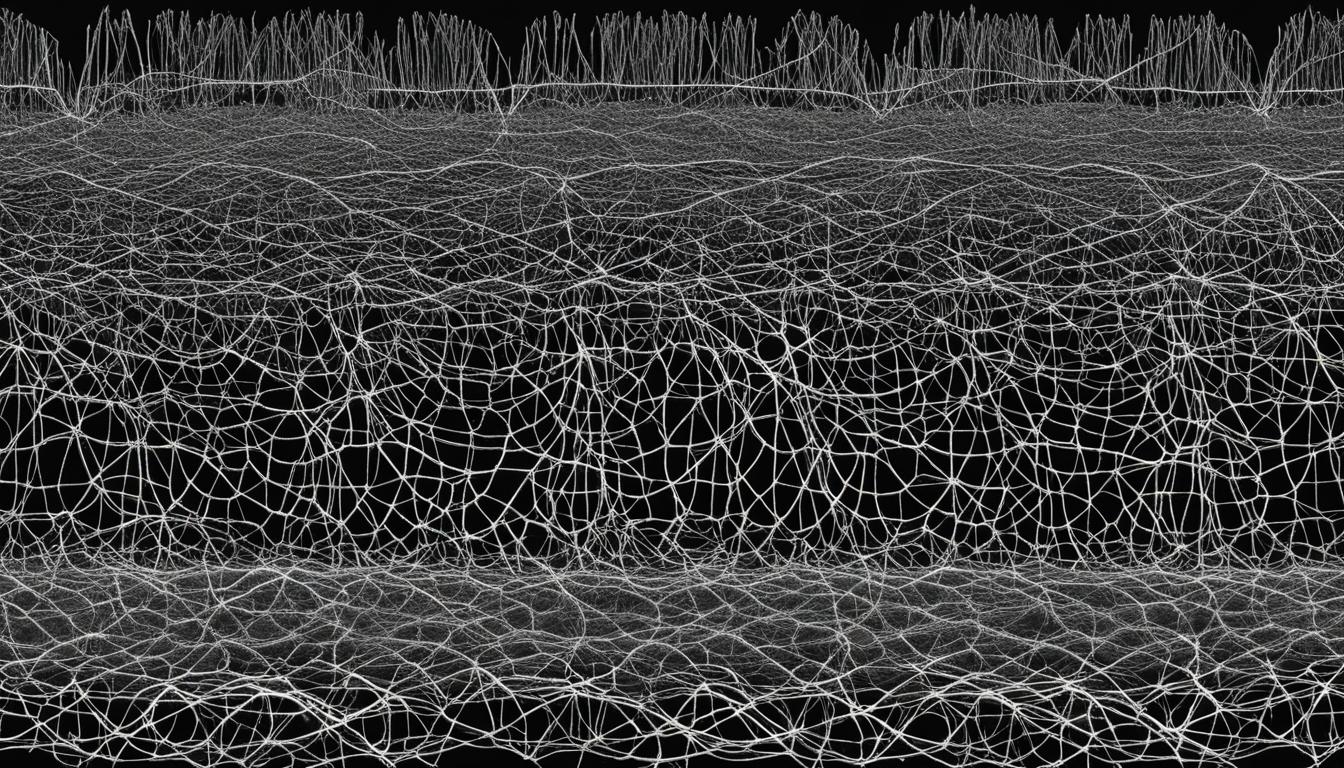Tech
Exploring Generative Adversarial Networks (GANs)

Welcome to our comprehensive examination of Generative Adversarial Networks (GANs), an innovative technique in the realm of deep learning. GANs have transformed sectors such as image creation, computer vision, and generative models, achieving significant advancements in artificial intelligence and machine learning.
At its core, GANs consist of two neural networks, the generator and the discriminator, which work together to generate realistic and high-quality synthetic data. This unique architecture allows GANs to learn from training data and create new, unseen data that closely resembles the original distribution.
With their ability to learn and mimic complex patterns, GANs have found diverse practical applications across industries. From generating realistic images to aiding in data augmentation and domain adaptation tasks, GANs continue to push the boundaries of what’s possible in the realm of artificial intelligence.
In this comprehensive article, we will delve into the theory and concepts behind GANs, explore different GAN variants and architectures, discuss practical implementation strategies, and examine their wide-ranging applications. We will also address the challenges faced by GANs and the potential future directions in this evolving field.
Key Takeaways:
- Generative Adversarial Networks (GANs) are a revolutionary approach in deep learning, enabling the generation of realistic synthetic data.
- GANs consist of a generator and discriminator, operating based on the minimax game objective.
- There are various GAN variants and architectures, including DCGAN, conditional GAN, CycleGAN, and StyleGAN.
- Practical implementation of GANs involves data preparation, network building, training algorithms, and evaluation and monitoring.
- GANs have numerous applications, including image synthesis, data augmentation, domain adaptation, and style transfer.
Understanding GANs: Theory and Concepts
Generative Adversarial Networks (GANs) are an exciting field of study in the realm of deep learning. GANs consist of two components: a generator and a discriminator. This dynamic duo works together to generate realistic synthetic data and distinguish it from real data. Let’s delve into the theory and concepts behind GANs.
The generator component of GANs is responsible for creating synthetic data. It takes in a random input and generates data that mimics the characteristics of the training dataset. The goal is to produce data that is indistinguishable from real data, fooling the discriminator.
The discriminator, on the other hand, acts as a detective. Its role is to assess whether the data it receives is real or generated. This discriminative ability is honed through continuous training, where the discriminator learns to distinguish the minute differences between real and synthetic data.
What sets GANs apart is their unique training objective, the minimax game. The generator aims to minimize the discriminator’s ability to differentiate between real and generated data, while the discriminator strives to improve its discrimination skills. This adversarial process allows both components to grow and enhance their capabilities iteratively.
By combining these concepts, GANs produce remarkable results in generating realistic and high-quality synthetic data. As we dive deeper into GANs, we’ll explore the various applications, challenges, and future directions in this fascinating field.
GAN Variants and Architectures
In the world of generative adversarial networks (GANs), there are various variants and architectures that have been developed to tackle different challenges and enhance the capabilities of these powerful models. Let’s explore some of the most notable ones:
DCGAN: Deep Convolutional GAN
DCGAN is a popular variant of GANs that leverages convolutional neural networks (CNNs) for image synthesis. By using convolutional layers, DCGAN is able to capture spatial features and generate more realistic images compared to traditional fully connected networks.
Conditional GAN
Conditional GANs take GANs a step further by introducing a conditional input, allowing for targeted generation based on specific attributes or labels. This enables more control over the generated output and paves the way for applications such as image modification, style transfer, and image-to-image translation.
CycleGAN
In situations where paired training data is scarce or unavailable, CycleGAN offers a solution for image-to-image translation tasks. By leveraging unpaired training data, CycleGAN learns to translate images from one domain to another without the need for explicit matching between the two domains, opening up possibilities for artistic expression and style transfer.
StyleGAN
If you’re looking for highly realistic and high-resolution image synthesis, StyleGAN is the architecture to turn to. StyleGAN allows for precise control over various style aspects of generated images, offering unprecedented quality and fidelity. This has led to impressive advancements in generating lifelike faces and even entire scenes that are almost indistinguishable from real photographs.
These are just a few examples of the diverse architectures and variants that have been developed within the GAN framework. Each of them offers unique features and capabilities, expanding the possibilities of generative modeling and pushing the boundaries of what AI can achieve.

| Step | Description |
|---|---|
| Data Preparation | Cleaning and normalizing training data to ensure accuracy and consistency |
| Building Networks | Designing the generator and discriminator networks for optimal performance |
| Training GAN Models | Iteratively optimizing both the generator and discriminator networks |
| Evaluation and Monitoring | Assessing the quality of generated samples and monitoring training progress |
Applications of GANs
Generative Adversarial Networks (GANs) have revolutionized the field of deep learning by offering a wide range of applications across various domains. Let’s explore some of the practical uses of GANs:
1. Image Synthesis
GANs excel at generating realistic images that closely resemble real photographs. This ability has applications in creating novel visual content for industries such as entertainment, fashion, and advertising. GANs can generate high-quality images that are indistinguishable from real ones, opening up new possibilities for designers and artists.
2. Data Augmentation
Data augmentation plays a crucial role in improving the generalization capability of machine learning models. GANs can generate synthetic data samples that enhance the diversity and quality of the training dataset. By augmenting the data, GANs help models better capture the underlying patterns and improve their performance on real-world test data.
3. Domain Adaptation
When a machine learning model trained on one domain fails to perform well on another, GANs can help bridge the gap through domain adaptation. By mapping data from the source domain to the target domain, GANs enable models to generalize effectively across different domains. This technique has applications in areas such as style transfer, where the visual style of an image is transformed to match the style of another domain.
4. Style Transfer
Style transfer is the process of applying the artistic style of one image to another, creating visually compelling results. GANs have been instrumental in achieving impressive style transfer capabilities, allowing users to apply the style of famous paintings or photographs to their own images. This is particularly valuable in the fields of graphic design, image editing, and artistic expression.
In summary, GANs have creative and practical applications in image synthesis, data augmentation, domain adaptation, and style transfer. Their ability to generate realistic images and facilitate the translation of visual content between different domains has opened up exciting possibilities for various industries.

| Application | Description |
|---|---|
| Image Synthesis | Generating realistic images for industries like entertainment and advertising. |
| Data Augmentation | Improving model generalization through synthetic data samples. |
| Domain Adaptation | Enabling models to generalize across different domains. |
| Style Transfer | Applying artistic styles to images for visual enhancement. |
Challenges and Future Directions
Generative Adversarial Networks (GANs) are an exciting field in the realm of deep learning and artificial intelligence. While GANs have shown remarkable potential in various applications, they also come with unique challenges that need to be addressed for further advancements.
Training Instability and Mode Collapse
One of the major challenges encountered in GANs is training instability. GAN models can be difficult to train, often resulting in mode collapse or the generator failing to produce diverse outputs. This limits the overall effectiveness and quality of the generated samples.
Improving GAN Architectures
To overcome the challenges associated with GANs, researchers are continuously exploring new architectures and techniques. Novel GAN architectures, such as Deep Convolutional GANs (DCGANs) and StyleGANs, have shown promising results in generating high-resolution and realistic images. This ongoing research aims to enhance the stability and diversity of GAN outputs.
Exploring Novel Loss Functions and Training Strategies
GANs heavily rely on loss functions to guide the training process. Researchers are experimenting with new loss functions and training strategies to improve the performance and convergence of GAN models. These advancements enable the generation of more accurate and diverse synthetic data.
Addressing Ethical Considerations
The rise of deepfakes and the potential misuse of GAN-generated content have raised important ethical concerns. Responsible use of GANs is crucial to ensure the protection of privacy and prevent the dissemination of misleading or harmful information. Researchers and policymakers are actively working towards developing ethical frameworks and regulations for GAN technology.
As the field of GANs continues to evolve, addressing these challenges and embracing future directions will pave the way for exciting advancements in generative modeling. By overcoming these obstacles and ensuring ethical practices, GANs have the potential to revolutionize the way we perceive and create artificial data.

| Generator | Discriminator |
|---|---|
| Generates synthetic data based on random input | Distinguishes between real and generated data |
| Aims to deceive the discriminator by producing realistic data | Improves its ability to classify real versus generated data |
| Enhances the quality of generated samples over time | Enhances its accuracy in differentiating real from generated data |
This constant competition and improvement make GANs a powerful tool for generating realistic data. With their unique architecture and dynamic training process, GANs have been successfully applied in various fields, including image synthesis, data augmentation, and style transfer.
As we delve deeper into the world of GANs, we’ll explore their practical implementations, challenges, and future directions in the next sections.
The “Hello World” of GANs
The MNIST dataset serves as a fundamental starting point for learning about generative adversarial networks (GANs). By leveraging neural networks, GANs aim to generate new and realistic images of handwritten digits, similar in quality to the MNIST dataset. The ultimate objective is to enhance the discriminator’s capability to distinguish between real-world and generated images.
Training GANs involves iterations until the discriminator achieves a desired level of accuracy, making it an exciting phenomenon in deep learning. Generating lifelike images of handwritten digits showcases GANs’ potential in fundamental image synthesis and paves the way for more complex applications in computer vision and other domains.
Inspired by the MNIST dataset, GANs demonstrate their ability to learn and generate diverse and high-quality images resembling human handwriting. Through GANs, we can explore the nuances of neural networks and the vast landscape of generative models.
Generating Digits with GANs
Let us dive deeper into the mechanics of GANs by comprehending the step-by-step process of generating digits:
- Training Data: GANs are trained on the MNIST dataset, which consists of a large collection of images of handwritten digits labeled with their respective classes (0-9).
- Discriminator Training: Initially, the discriminator is trained using real images from the MNIST dataset, fine-tuning its ability to accurately classify between real and generated images.
- Generator Training: Simultaneously, the generator starts creating synthetic images using random noise as input. The generator’s primary objective is to create images that fool the discriminator into classifying them as real, thereby improving its own performance.
- Minimax Game: The discriminator and generator engage in a minimax game, with the generator aiming to generate images that are indistinguishable from real images, while the discriminator attempts to correctly classify real versus generated images.
- Iteration and Improvement: Through multiple training iterations, the discriminator’s ability to distinguish between real and generated images improves, while the generator enhances its proficiency in generating high-quality synthetic images.
With GANs, we strive to achieve a state where the generated images closely resemble the real, high-quality images present in the MNIST dataset. This process serves as the “Hello World” of GANs, allowing us to delve deeper into the capabilities and potential applications of generative adversarial networks.
GANs enable us to generate intricate representations of handwritten digits, replicating the intricacies of the MNIST dataset. By leveraging neural networks and training algorithms, GANs can bring complexity and realism to synthesized images, pushing the boundaries of what is achievable in generative modeling.
Uses and Ethics of GANs
Generative Adversarial Networks (GANs) have revolutionized the field of image processing, offering a wide range of applications. One of the key uses of GANs is in image translation and generation tasks, where they excel in producing realistic and high-quality images. GANs have been employed in various domains, including art, design, entertainment, and even medical imaging. The ability of GANs to generate new images based on existing data opens up endless creative possibilities.
However, the power of GANs also raises important ethical considerations. One of the primary concerns is the creation of indistinguishable generated data, which can have potential negative implications. GANs can be used to create realistic deepfakes, forged images, and other fabricated media that can deceive individuals or be used for malicious purposes. This raises questions about the responsible use of GANs and the potential impact on privacy, security, and trust.
Responsible use of GANs is vital to ensure positive societal impacts. Ethical guidelines and regulations are being developed to address the ethical challenges associated with GANs. These guidelines aim to mitigate the risks while fostering innovation and creativity. Adherence to these ethical guidelines promotes transparency, accountability, and fairness in the use of GANs.
“With great power comes great responsibility.”
In the case of GANs, this famous quote rings true. As creators and users of GANs, we have the responsibility to utilize this technology ethically, respecting privacy, consent, and the well-being of individuals affected by the generated content.
Key Ethical Considerations
Exploring the ethical implications of GANs is crucial for understanding their societal impact:
- Data Privacy: GANs require large amounts of data to generate realistic outputs. Ensuring the privacy and consent of data subjects is essential to prevent misuse of personal information.
- Authenticity and Trust: The ability of GANs to generate highly realistic images challenges the notion of trust and authenticity. Efforts should be made to develop methods for detecting and verifying generated content to preserve trust.
- Unintended Consequences: The use of GANs can have unintended consequences, such as perpetuating biases present in training data or creating realistic but fabricated information. Awareness and mitigation strategies should be implemented to address these issues.
- Regulation and Governance: The development of regulations and governance frameworks is necessary to ensure responsible use of GANs, balancing innovation with societal well-being. Collaboration among researchers, policymakers, and industry experts is essential in shaping these frameworks.
| Ethical Considerations | Implications |
|---|---|
| Data Privacy | Potential misuse of personal information |
| Authenticity and Trust | Challenges in verifying and detecting generated content |
| Unintended Consequences | Perpetuation of biases and fabricated information |
| Regulation and Governance | Balancing innovation and societal well-being |
Addressing these ethical considerations will contribute to harnessing the potential of GANs for positive societal impacts, while mitigating the risks associated with their misuse.
Image: Generative Adversarial Networks (GANs) are powerful tools for image processing tasks, but their use must be guided by ethical considerations.
GANs and Phonological Representations
When exploring the potential applications of generative adversarial networks (GANs), one intriguing area of study is their use in analyzing phonological phenomena and encoding them into categorical representations.
While GANs are not specifically designed for phonetics or linguistics, they exhibit the ability to distinguish between contrastive and non-contrastive phonological features in different languages. This presents an exciting opportunity to delve into the relationship between GANs and phonological representations proposed by linguists.
However, it is important to note that there may be differences between the learned representations in GANs and the phonological representations proposed by linguists. GANs operate based on their training data and the objective function, which may lead to distinct learned representations.
In order to better understand the potential of GANs in analyzing phonological phenomena, further research is necessary to investigate the characteristics and limitations of these learned representations. This exploration can provide insights into the intersection of GANs and phonetics, offering new perspectives on language processing and representation.
GANs and Contrastive Phonological Features
One fascinating aspect of GANs is their ability to distinguish between contrastive phonological features in different languages. Contrastive features are linguistic elements that differentiate between words or sounds in a language. GANs show promising capabilities in capturing and representing these contrastive features.
“The ability of GANs to learn contrastive phonological features has significant implications for linguistic research. By analyzing the encoded representations in GANs, we can gain a deeper understanding of how different languages leverage phonological contrasts.”
For example, researchers have used GANs to analyze phonological contrasts in languages such as English, Spanish, and Mandarin Chinese. By training GANs on phonetic data, they were able to identify and visualize the learned representations corresponding to the contrastive phonological features in each language.
Comparative Analysis of Phonological Feature Learning
A comparative analysis of GANs learning from different languages provides valuable insights into the contribution of language-specific features to phonological representations. By training GANs on phonetic data from multiple languages, we can gain a deeper understanding of how GANs learn and represent phonological features across different linguistic contexts.
Such a comparative analysis can shed light on the universal and language-specific aspects of phonological representations encoded by GANs. It allows us to explore the commonalities and differences in phonetic patterns across languages, paving the way for cross-linguistic studies and the development of more comprehensive phonological models.
| Language | Contrastive Feature 1 | Contrastive Feature 2 | Contrastive Feature 3 |
|---|---|---|---|
| English | Voicing (/b/ vs. /p/) | Nasality (/m/ vs. /n/) | Place of Articulation (/t/ vs. /k/) |
| Spanish | Sibilance (/s/ vs. /θ/) | Rhoticity (/r/ vs. /l/) | Pitch Stress (á vs. a) |
| Mandarin Chinese | Tone (mā vs. má) | Aspiration (/pʰ/ vs. /p/) | Mid Vowels (ē vs. ǝ) |
*Note: The table above provides a simplified illustration of contrastive phonological features in English, Spanish, and Mandarin Chinese.
By examining the learned representations in GANs trained on phonetic data from various languages, we can gain insights into how GANs encode and differentiate between contrastive phonological features. This analysis contributes to our understanding of the underlying mechanisms of phonetic processing.
Throughout the analysis, it is important to consider factors such as the amount and distribution of training data for each language, potential biases in the data, and the impact of different phonetic inventories and sound systems.
By leveraging the power of GANs, we can uncover new perspectives on phonological phenomena and gain valuable insights into the representation of language-specific features. This fusion of linguistics and deep learning opens doors for further exploration and advances our understanding of phonetic processing and representation.
Comparative Analysis of GANs Learning from Different Languages
When it comes to generative adversarial networks (GANs), understanding their ability to learn from different languages is crucial in uncovering the role of language-specific features in phonological representations. By comparing the performance of GANs on different languages, we can gain valuable insights into how these networks capture and utilize the unique characteristics of each language.
In the field of phonological feature learning, GANs offer a promising approach to encoding phonological phenomena into categorical representations. However, it is important to note that there may be discrepancies between the learned representations in GANs and the phonological representations proposed by linguists. This comparative analysis of GANs learning from different languages allows us to explore the relationship between language-specific features and the phonological representations generated by GANs.
By examining the performance of GANs across multiple languages, we can identify patterns and variations in how these networks capture and represent phonological features. This analysis enables us to better understand the contribution of language-specific characteristics to the phonological representations generated by GANs.
Furthermore, this comparative analysis provides valuable insights for researchers and linguists studying phonological feature learning. Understanding how GANs learn from different languages can enhance our knowledge of phonological feature acquisition and representation, advancing our understanding of language processing and linguistic theory.
Insights from Comparative Analysis
Through the comparative analysis of GANs learning from different languages, we can draw important insights into the relationship between language-specific features and phonological feature learning. Here are some potential findings that can emerge from such an analysis:
- The impact of phoneme inventories: Different languages have distinct phoneme inventories, which can influence the discriminability and learning of phonological features by GANs.
- Morphological complexity: Languages with complex morphological systems may present challenges for GANs in capturing and representing morphological features.
- Tonal languages: GANs learning from tonal languages can provide insights into how these networks handle and represent tonal features, which are crucial in tonal language processing.
- Phonological universals: Comparative analysis can help identify common phonological features and structures that GANs consistently capture across different languages, shedding light on phonological universals.
“Comparative analysis of GANs learning from different languages offers a unique opportunity to examine the role of language-specific features in phonological representations. By exploring these insights, we can further advance our understanding of phonological feature learning and its relationship to language diversity.”
Overall, the comparative analysis of GANs learning from different languages provides a valuable lens through which we can examine phonological feature learning. Understanding how GANs learn from different languages contributes to our broader understanding of language processing, linguistic theory, and the potential of generative adversarial networks in capturing the intricacies of human language.
Training Data Frequencies in Phonological Feature Learning
In the context of phonological feature learning in Generative Adversarial Networks (GANs), the role of training data frequencies is crucial for developing language-specific phonological representations. The frequencies of training data can impact the accuracy and effectiveness of the feature learning process within GANs.
By training GANs with datasets that accurately reflect the frequencies of phonological features in a specific language, we can facilitate the learning of phonological representations that align with the target language’s phonetic structure. This approach ensures that the GANs capture the unique phonological patterns and distinctions present in the language.
For example, let’s consider a GAN trained on a dataset that heavily favors certain phonological features over others, resulting in an imbalanced representation of the language. This biased training data frequency may hinder the GAN’s ability to accurately learn and generate phonological features, leading to less robust and reliable results.
On the other hand, when GANs are trained with a diverse dataset that represents the true distribution of phonological features in the target language, the models can capture the nuances and intricacies of the language’s phonological system. This enables the GANs to generate more accurate and realistic phonological representations.
It is important to carefully curate training data with balanced frequencies of phonological features to foster optimal learning within GANs. Additionally, considering the dialectal and regional variations within a language can further enhance the phonological feature learning process.
The graphic below illustrates the impact of training data frequencies on phonological feature learning in GANs:
Phonological Feature Frequencies in Training Data
| Phonological feature | High Frequency | Low Frequency |
|---|---|---|
| Consonant /b/ | 823 | 154 |
| Consonant /k/ | 712 | 287 |
| Vowel /i/ | 985 | 94 |
| Vowel /a/ | 812 | 189 |
By providing training data with balanced frequencies of phonological features, we enable GANs to effectively learn the distinct phonetic characteristics of a language. This ensures that the generated phonological representations are accurate and reliable, contributing to advancements in phonological feature learning within GANs.
By understanding the impact of training data frequencies in phonological feature learning, we can optimize GAN-based approaches for modeling and generating language-specific phonological representations effectively. This knowledge opens up exciting possibilities for various applications, such as automatic speech recognition, voice synthesis, and language preservation.
Conclusion
Generative Adversarial Networks (GANs) have revolutionized the field of deep learning. By understanding the concepts and techniques of GANs, we can explore practical implementations and various applications. GANs continue to evolve, facing challenges and future directions, while also raising ethical considerations for responsible use.
The power of GANs lies in their ability to generate realistic and high-quality synthetic data, making them valuable tools in artificial intelligence and machine learning. With their unique architecture comprised of a generator and discriminator, GANs operate based on the minimax game objective to create a competitive learning environment.
Through the training process, GANs learn to generate data that closely resembles the real data they were trained on. This ability has profound implications in diverse domains such as computer vision, image synthesis, data augmentation, domain adaptation, and style transfer.
However, GANs also present challenges such as training instability and mode collapse. Ongoing research and advancements in GAN architectures, loss functions, and training strategies aim to address these challenges and improve the performance and stability of GAN models.
Furthermore, ethical considerations are crucial when applying GANs. The power of GANs to generate indistinguishable synthetic data raises concerns regarding the potential misuse of deepfakes and the responsible use of GAN-generated content.
In conclusion, Generative Adversarial Networks (GANs) are a game-changing technology in the field of deep learning. They offer endless possibilities for generating high-quality synthetic data, pushing the boundaries of AI and opening new avenues of research and innovation. By embracing GANs and understanding their complexities, we can unlock their full potential and contribute to the advancement of artificial intelligence.
Invitation to Explore GANs and AI
At the intersection of generative adversarial networks (GANs) and the broader field of artificial intelligence (AI), lies a world of limitless possibilities for exploration and innovation. GANs have revolutionized the field of deep learning, offering a powerful tool for generating realistic and high-quality synthetic data.
By delving into the realm of GANs, you have the opportunity to contribute to the advancement of AI and push the boundaries of generative modeling. Whether you are a researcher, practitioner, or simply curious about the fascinating world of AI, there are numerous avenues for you to explore.
With GANs, you can dive into image synthesis, data augmentation, domain adaptation, and style transfer, among many other exciting applications. These techniques are not only limited to the realm of computer vision but can also be applied to various fields such as natural language processing, music generation, and even healthcare.
Immerse yourself in the concepts and principles of GANs, unravel the intricacies of training algorithms, and unlock the potential of generative models. As you embark on this journey, you will not only expand your knowledge but also contribute to the ongoing advancements in AI and its transformative impact on society.
“The power of GANs lies in their ability to challenge the boundaries of creativity and innovation, enabling machines to mimic the human imagination in unprecedented ways.”
The Future of GANs and AI
As GANs continue to evolve, there are exciting opportunities on the horizon. Researchers are actively exploring new architectures, novel loss functions, and training strategies to overcome challenges such as training instability and mode collapse.
Ethical considerations regarding deepfakes and responsible use of GANs are being addressed to ensure their positive societal impact. The collaboration between humans and AI will pave the way for groundbreaking advancements in various industries, shaping a future where AI augments human creativity and solves complex problems.
Join the Exploration
We invite you to join us in the exploration of GANs and AI. Let’s embark on this journey together, uncovering new frontiers and shaping the future of generative modeling. Together, we can harness the power of AI to create a world where imagination knows no bounds.
Are you ready to dive into the world of GANs and AI? Join us on this exhilarating adventure and be at the forefront of cutting-edge technology.
| Benefits of Exploring GANs and AI | Areas of Exploration |
|---|---|
| 1. Advancement of artificial intelligence | 1. Image synthesis |
| 2. Pushing the boundaries of generative modeling | 2. Data augmentation |
| 3. Contributing to the ongoing research | 3. Domain adaptation |
| 4. Unlocking the creative potential of machines | 4. Style transfer |
| 5. Solving complex real-world problems | 5. Natural language processing |
| 6. Shaping a future where AI augments human creativity | 6. Music generation |
| 7. Healthcare applications |
Acknowledgments
We extend our heartfelt gratitude to the dedicated researchers, practitioners, and the wider AI community for their invaluable contributions and insights in the development and understanding of Generative Adversarial Networks (GANs).
Their unwavering commitment to pushing the boundaries of artificial intelligence and advancing the field of generative modeling has paved the way for groundbreaking innovations and discoveries.
Without their tireless efforts and collective expertise, the progress made in GANs would not have been possible. We are genuinely thankful for the collaborative spirit and the shared passion in exploring the potentials of GANs.
Generative Adversarial Networks (GANs) are a groundbreaking approach in deep learning for generating realistic and high-quality synthetic data. GANs consist of two neural networks, the generator and the discriminator, and operate based on the minimax game objective.
GANs are composed of a generator and a discriminator. The generator aims to produce realistic synthetic data, while the discriminator distinguishes between real and generated data. GANs operate based on the minimax game objective, with the generator minimizing the discriminator’s ability to differentiate between real and generated data.
There are various GAN variants and architectures. DCGAN utilizes convolutional neural networks for image synthesis. Conditional GAN allows for targeted generation based on specific attributes or labels. CycleGAN enables image-to-image translation without paired training data. StyleGAN focuses on generating high-resolution and highly realistic images with control over different style aspects.
Effective implementation of GAN models involves data preparation, building generator and discriminator networks, training GAN models iteratively, and evaluating and monitoring performance. Data preparation includes cleaning and normalizing training data. Building networks involves designing architectures for the generator and discriminator. Training GAN models involves iterative optimization of both networks. Evaluation and monitoring assess the quality of generated samples and convergence of the training process. GANs have found applications in various domains. They can be used for image synthesis, data augmentation to improve model generalization, domain adaptation, and style transfer tasks. GANs have creative and practical applications in generating realistic images and translating images between different domains.
GANs present challenges such as training instability and mode collapse. However, ongoing research focuses on improving GAN architectures, exploring novel loss functions and training strategies. Ethical considerations regarding deepfakes and responsible use of GANs are also being addressed.
GANs involve two neural networks, the generator and the discriminator. The generator generates synthetic data based on random input, while the discriminator improves its ability to classify the generated data. GANs have adversarial aspects where the generator and discriminator compete and improve their respective abilities.
The MNIST dataset is often used as a starting point for learning about GANs. The goal is to generate new images of handwritten digits that match the quality of the MNIST dataset and improve the discriminator’s ability to classify real-world versus generated images. GANs can be trained until the discriminator achieves a desired level of accuracy.
GANs have a wide range of uses in image processing tasks such as image translation and generation. However, the power of GANs raises ethical considerations, especially with indistinguishable generated data. Responsible use of GANs is important to ensure positive societal impacts. GANs can be used to analyze phonological phenomena and encode them into categorical representations. However, there are differences between the learned representations in GANs and phonological representations proposed by linguists. GANs show the ability to distinguish contrastive and non-contrastive phonological features in different languages.
Comparing the performance of GANs learning from different languages provides insights into the contribution of language-specific features to phonological representations. Understanding how GANs learn from different languages can enhance our knowledge of phonological feature learning.
The role of training data frequencies in phonological feature learning is important to consider. Different frequencies of training data may impact the development of language-specific phonological representations in GANs.
Generative Adversarial Networks (GANs) have revolutionized the field of deep learning. By understanding the concepts and techniques of GANs, we can explore practical implementations and various applications. GANs continue to evolve, facing challenges and future directions, while also raising ethical considerations for responsible use.
GANs and the broader field of AI offer exciting opportunities for exploration and innovation. By delving into GANs, you can contribute to the advancement of artificial intelligence and push the boundaries of generative modeling. We would like to acknowledge the contributions and insights of researchers, practitioners, and the broader AI community in the development and understanding of Generative Adversarial Networks (GANs).
FAQ
What are Generative Adversarial Networks (GANs)?
How do GANs work?
What are some GAN variants and architectures?
How do you implement GANs in practice?
What are the applications of GANs?
What are the challenges and future directions of GANs?
How do the generator and discriminator networks in GANs operate?
What is the “Hello World” of GANs?
What are the uses and ethical considerations of GANs?
How do GANs relate to phonological representations?
What insights can we gain from comparing GANs learning from different languages?
How does training data frequencies impact phonological feature learning in GANs?
What are the main takeaways from exploring GANs?
What opportunities does AI and GANs offer?
Who should be acknowledged for the development and understanding of GANs?
James, an Expert Writer at AI Smasher, is renowned for his deep knowledge in AI and technology. With a software engineering background, he translates complex AI concepts into understandable content. Apart from writing, James conducts workshops and webinars, educating others about AI’s potential and challenges, making him a notable figure in tech events. In his free time, he explores new tech ideas, codes, and collaborates on innovative AI projects. James welcomes inquiries.
Tech
Deep Learning: AI’s Secret Sauce Unveiled
Prepare to be amazed, everyone, as we delve into the world of deep learning. Today, we uncover the crucial element behind AI’s remarkable capabilities.
Brace yourselves for a journey through the intricacies of neural networks, where convolutional and recurrent models dance harmoniously, while generative adversarial networks push the boundaries of innovation.
Get ready to witness the power of deep learning as we unravel its mysteries and unlock the potential for groundbreaking advancements in artificial intelligence.
Key Takeaways
- Transfer learning allows models to leverage knowledge from one task for another.
- Deep learning techniques revolutionize the field of AI.
- Convolutional Neural Networks (CNN) are designed for image recognition tasks.
- Generative Adversarial Networks (GAN) are a framework for training generative models.
Overview of Deep Learning Techniques
In this section, we’ll be exploring the various deep learning techniques that are revolutionizing the field of AI.

One of the key techniques that has gained significant attention is transfer learning. This approach allows a model to leverage knowledge gained from one task and apply it to another related task. By transferring the learned features, the model can achieve better performance with less training data.
Another important technique is unsupervised learning, which enables the model to learn patterns and relationships in data without explicit labels. This technique is particularly valuable when labeled data is scarce or expensive to obtain. Unsupervised learning algorithms, such as autoencoders and generative adversarial networks, have shown great promise in tasks like anomaly detection and data generation.
Now, let’s delve into the world of neural networks and deep learning, where these techniques truly shine.
Neural Networks and Deep Learning
Let’s dive into the world of neural networks and uncover the power of deep learning.

Neural networks are at the heart of deep learning, enabling machines to learn and make decisions similar to humans. These networks are composed of interconnected nodes, called neurons, which process and transmit information.
Deep learning, powered by neural networks, has found many applications across various industries. It has revolutionized image and speech recognition, natural language processing, and recommendation systems. Deep learning models have also achieved remarkable results in medical diagnosis, autonomous vehicles, and financial forecasting.
However, neural networks do have limitations. They require large amounts of labeled data for training, and they can be computationally expensive and time-consuming. Additionally, neural networks are often considered black boxes, making it challenging to interpret their decisions.
Despite these limitations, the applications of deep learning continue to expand, driving innovation and pushing the boundaries of artificial intelligence.

Convolutional Neural Networks (CNN)
We will now explore the power of Convolutional Neural Networks (CNN) in the world of deep learning. CNNs are a type of neural network specifically designed for image recognition tasks. They excel at extracting features from raw pixel data and have revolutionized the field of computer vision. One of the key strengths of CNNs is their ability to automatically learn and identify meaningful patterns in images through a process called feature extraction. This process involves applying multiple convolutional filters to the input image, which then detect different features such as edges, textures, and shapes. These extracted features are then used by the network to classify and recognize objects within the image. CNNs have proven to be highly effective in various applications such as facial recognition, object detection, and autonomous driving.
| Advantages | Limitations |
|---|---|
| Excellent performance in image recognition tasks | Requires large amounts of labeled training data |
| Automatically learns and extracts meaningful features | Computationally expensive |
| Can handle complex and high-dimensional data | Interpretability can be challenging |
Recurrent Neural Networks (RNN)
Recurrent Neural Networks (RNN) provide a powerful framework for understanding and analyzing sequential data. One popular type of RNN is the Long Short Term Memory (LSTM) network, which addresses the vanishing gradient problem and allows for better modeling of long-term dependencies in the data.
The applications of RNN in Natural Language Processing (NLP) are vast. RNNs can be used for tasks such as language translation, sentiment analysis, and text generation. By processing text data sequentially, RNNs can capture the contextual information necessary for these tasks.
Moreover, RNNs can also be applied to speech recognition and handwriting recognition. With their ability to handle sequential data, RNNs have revolutionized the field of NLP and opened up new possibilities for AI-driven language processing.

Moving forward, let’s explore another exciting topic: generative adversarial networks (GAN).
Generative Adversarial Networks (GAN)
To delve deeper into the realm of AI, we now shift our attention to the innovative concept of Generative Adversarial Networks (GAN). GANs are a powerful framework for training generative models. They consist of two components: a generator and a discriminator.
The generator learns to produce data that resembles the training set, while the discriminator learns to distinguish between real and generated data. GANs have found various applications in image synthesis, text generation, and voice conversion, among others.
One of the key advantages of GANs is their ability to learn from unlabeled data, making them particularly useful in scenarios where labeled data is scarce. GAN training techniques, such as adversarial training and gradient-based optimization, have been developed to train these models effectively.

GANs are a promising area of research in AI and hold great potential for innovation in various domains.
Frequently Asked Questions
How Does Deep Learning Differ From Other Machine Learning Techniques?
Deep learning differs from other machine learning techniques by using neural networks to learn and make predictions. It can handle complex tasks like image and speech recognition, and has real world applications in self-driving cars and virtual assistants.
What Are the Main Challenges in Training Deep Neural Networks?
Training deep neural networks presents challenges due to data scarcity and computational complexity. These hurdles require innovative solutions to optimize performance and overcome limitations, pushing the boundaries of what AI can achieve.
Can Deep Learning Models Be Easily Interpretable or Explainable?
Deep learning models, although powerful, are not easily interpretable or explainable. This lack of interpretability poses limitations and challenges in understanding the inner workings and decision-making processes of these models.

How Does the Size of the Training Dataset Affect the Performance of Deep Learning Models?
The size of the training dataset greatly affects the performance of deep learning models. With data scarcity, models may suffer from overfitting, reducing their ability to generalize to new data.
Are There Any Ethical Concerns Associated With the Use of Deep Learning in AI Applications?
Ethical implications arise from the use of deep learning in AI applications, impacting society in various ways. It is crucial to consider the potential biases, privacy concerns, and job displacement associated with this powerful technology.
Conclusion
In conclusion, deep learning techniques have revealed the secret sauce of artificial intelligence. Neural networks, such as Convolutional Neural Networks and Recurrent Neural Networks, have played a crucial role in achieving remarkable results.
However, let’s not forget the power of irony in this context. While these advancements may seem impressive, they also raise important questions about the future of human intelligence and our reliance on machines.

Hanna is the Editor in Chief at AI Smasher and is deeply passionate about AI and technology journalism. With a computer science background and a talent for storytelling, she effectively communicates complex AI topics to a broad audience. Committed to high editorial standards, Hanna also mentors young tech journalists. Outside her role, she stays updated in the AI field by attending conferences and engaging in think tanks. Hanna is open to connections.
Tech
Curated Insights: Latest Breakthroughs in Machine Learning Tech

We have explored the cutting-edge field of machine learning to bring you the most remarkable technological advancements.
Our curated insights will enlighten and excite as we delve into the latest advancements in deep learning algorithms, emerging applications, data analysis techniques, natural language processing trends, and innovative computer vision and image recognition.
Prepare to be amazed by the limitless possibilities and groundbreaking discoveries that await in the ever-evolving world of machine learning tech.
Key Takeaways
- Real-time fraud detection and anomaly detection for fraud prevention are crucial applications of machine learning in various industries.
- Transfer learning techniques and reinforcement learning algorithms have led to significant advancements in deep learning algorithms, with applications in robotics and game playing.
- Cutting-edge techniques for data analysis, such as real-time predictions and insights, have enhanced decision-making processes and enabled proactive measures based on data analysis.
- Natural language processing has seen advancements in sentiment analysis, language translation models, and understanding human emotions in text, providing valuable insights for businesses.
Emerging Applications of Machine Learning
In our article, we explore the emerging applications of machine learning, focusing on how this technology is transforming various industries.

One such application is real-time fraud detection. Machine learning algorithms can analyze vast amounts of data in real-time, identifying patterns and anomalies that may indicate fraudulent activity. By continuously learning from new data, these systems can adapt and improve their accuracy over time, helping businesses detect and prevent fraud more effectively.
Another exciting application is personalized recommendation systems. Machine learning algorithms can analyze user behavior, preferences, and historical data to provide personalized recommendations for products, services, or content. These recommendations can enhance user experience, increase customer satisfaction, and drive sales.
Advancements in Deep Learning Algorithms
With the advent of new technologies and the increasing availability of large datasets, we’re witnessing remarkable advancements in the capabilities of deep learning algorithms.
Transfer learning techniques have emerged as a powerful tool in deep learning, allowing models to leverage knowledge learned from one task and apply it to another, even in different domains. This approach reduces the need for training from scratch and enables faster convergence and improved performance.

Additionally, reinforcement learning algorithms have made significant progress in solving complex problems by learning through interactions with an environment. These algorithms use trial and error to optimize decision-making processes, leading to breakthroughs in areas such as robotics and game playing.
As deep learning continues to evolve, these advancements pave the way for cutting-edge techniques in data analysis, enabling us to extract valuable insights from vast amounts of information.
Cutting-Edge Techniques for Data Analysis
As we delve into the realm of cutting-edge techniques for data analysis, our exploration of advancements in machine learning continues to uncover new and exciting possibilities.
One such possibility is the ability to make real-time predictions and detect anomalies in data. Real-time predictions refer to the capability of providing immediate insights and actionable information as new data streams in. This is particularly valuable in industries where timely decision-making is crucial, such as finance or healthcare.

Anomaly detection, on the other hand, focuses on identifying patterns or events that deviate significantly from the norm. By leveraging machine learning algorithms, data analysts can now identify anomalies that may indicate potential fraud, system failures, or other critical issues. These cutting-edge techniques not only enhance decision-making processes but also allow for proactive measures to be taken.
Moving forward, let’s explore the latest trends in natural language processing and how they’re revolutionizing the way we interact with machines.
Latest Trends in Natural Language Processing
Continuing our exploration of cutting-edge techniques for data analysis, we now turn our attention to the latest trends in natural language processing, revolutionizing the way we interact with machines.
In recent years, significant advancements have been made in sentiment analysis, allowing machines to understand and interpret human emotions expressed in text. By analyzing the sentiment behind customer reviews, social media posts, and other textual data, businesses can gain valuable insights into customer satisfaction and make informed decisions to improve their products or services.

Additionally, language translation has seen remarkable enhancements, with the development of neural machine translation models that outperform traditional statistical approaches. These models utilize deep learning algorithms to capture the semantic meaning of sentences, resulting in more accurate and fluent translations.
As we delve into innovations in computer vision and image recognition, we witness a fascinating convergence of technology, where machines can’t only understand our words but also perceive and interpret visual information.
Innovations in Computer Vision and Image Recognition
We explore the exciting realm of computer vision and image recognition, where machines can now not only understand our words but also perceive and interpret visual information. This field is witnessing remarkable advancements that have the potential to revolutionize various industries.
Here are some of the latest breakthroughs:

-
Object Detection: Computer vision algorithms are becoming highly accurate in detecting and localizing objects in images and videos. This is crucial for applications such as surveillance systems and autonomous vehicles.
-
Image Segmentation: Advanced techniques are enabling machines to segment images into different regions, allowing for more precise analysis. This can be valuable in medical imaging for identifying tumors or in robotics for object manipulation.
-
Scene Understanding: With the ability to recognize scenes and understand the context, computer vision systems can now assist in tasks like navigation for autonomous vehicles or guiding robots in complex environments.
-
Deep Learning: The utilization of deep neural networks has significantly improved the accuracy and efficiency of computer vision algorithms, opening up new possibilities for advanced robotics and autonomous vehicles.

These developments in computer vision and image recognition hold great promise for industries seeking innovation in areas like advanced robotics and autonomous vehicles. By leveraging these technologies, we can enable machines to perceive and understand visual information, leading to safer and more efficient systems.
Frequently Asked Questions
How Does Machine Learning Technology Impact the Healthcare Industry?
Machine learning technology positively impacts the healthcare industry through predictive analytics and personalized medicine. It enables us to analyze vast amounts of data, identify patterns, and make accurate predictions, revolutionizing patient care and treatment outcomes.
What Are the Ethical Considerations Associated With the Use of Deep Learning Algorithms?
When it comes to the ethical considerations of deep learning algorithms, privacy concerns and bias detection are at the forefront. We must address these issues to ensure the responsible and unbiased use of this powerful technology.
How Can Machine Learning Techniques Be Applied to Improve Cybersecurity?
Machine learning techniques can greatly enhance cybersecurity by enabling advanced malware detection and anomaly detection. These innovations offer a proactive approach to identifying and mitigating cyber threats, leading to improved overall security.

What Are the Challenges in Implementing Natural Language Processing in Real-Time Conversational Systems?
Implementing natural language processing in real-time conversational systems presents challenges such as processing speed, accuracy, and understanding context. These challenges hinder effective implementation and require continuous research and innovation in machine learning technology.
How Can Computer Vision and Image Recognition Be Used to Enhance Autonomous Vehicles?
Computer vision and image recognition are revolutionizing autonomous vehicles. By applying these technologies, we can enhance safety, improve object detection, and enable advanced navigation systems. Computer vision also finds applications in agriculture and image recognition benefits the retail industry.
Conclusion
In conclusion, the latest breakthroughs in machine learning technology have opened up exciting possibilities for various applications.
The advancements in deep learning algorithms have allowed for more accurate and efficient analysis of complex data.

Cutting-edge techniques for data analysis have revolutionized the way we extract insights from large datasets.
The latest trends in natural language processing have made significant progress in understanding and generating human language.
Innovations in computer vision and image recognition have improved our ability to analyze and interpret visual content.
These advancements are propelling the field of machine learning towards new frontiers of innovation and discovery.

Hanna is the Editor in Chief at AI Smasher and is deeply passionate about AI and technology journalism. With a computer science background and a talent for storytelling, she effectively communicates complex AI topics to a broad audience. Committed to high editorial standards, Hanna also mentors young tech journalists. Outside her role, she stays updated in the AI field by attending conferences and engaging in think tanks. Hanna is open to connections.
Tech
Website Hijackers Manipulate Google Search Results

Dear audience, prepare to be astonished. This informative article will delve into the specific strategies employed by website hijackers to manipulate Google search results.
Brace yourselves for a journey into the dark corners of the internet, where hackers exploit vulnerabilities in popular platforms like WordPress.
As we delve deeper, we will shed light on the devastating consequences faced by website owners and users alike.
Get ready to break free from ignorance and discover the shocking truth behind website hijacking.

Key Takeaways
- Hackers compromise websites, particularly those using the open-source version of WordPress, to gain access through the administrator login.
- Injected links are added by hackers to manipulate search engine results, improving rankings and attracting more traffic to customer websites.
- Website owners may suffer financial loss and damage to their reputation, while users may be exposed to inappropriate or malicious content.
- Search engines like Google are manipulated by shady digital marketers and hackers through tactics such as acquiring once-credible websites and launching manipulation campaigns.
Methods Used by Website Hijackers
Website hijackers employ various tactics to manipulate search engine results and gain unauthorized access to websites. These hackers often target websites that use the open-source version of WordPress, taking advantage of vulnerabilities in outdated installations and plugins.
By compromising the administrator login, they can inject links into the website to manipulate search engine rankings. These injected links are then sold through online marketplaces, allowing the hijackers to profit from their illicit activities.
The impact on website owners and users can be significant, with financial loss, damage to reputation, and exposure to inappropriate or malicious content.
To prevent website hijacking, website owners should take preventive measures such as keeping their WordPress installations and plugins up to date, using strong passwords, and implementing security plugins.

Regular security audits and monitoring can also help detect and prevent unauthorized access.
Impact on Website Owners and Users
As website owners and users, we’re greatly affected by the impact of injected links and website hijacking.
One of the major consequences we face is the financial loss resulting from website hijacking. When hackers manipulate search engine results by injecting unauthorized backlinks, it can lead to a decrease in website traffic and potential customers, ultimately impacting our revenue.
Moreover, website hijacking can also damage our reputation, as users may be exposed to inappropriate or malicious content.

To prevent website hijacking, we must employ effective strategies. Regularly updating and patching our website’s software, especially if we’re using open-source platforms like WordPress, is crucial.
Additionally, implementing strong security measures such as two-factor authentication, using reputable plugins, and conducting regular security audits can help safeguard our websites from potential attacks.
Examples of Websites Affected by Injected Links
We have observed various websites, including those of lifestyle blogger Molly Stillman and the Canadian urban magazine Spacing, being impacted by injected links. Molly Stillman discovered unauthorized links on her blog, while Spacing found unauthorized links added to their articles. These examples highlight the vulnerability of websites to injected links and the need for strategies to prevent them.
To prevent injected links on websites, website owners should regularly update their content management systems, plugins, and themes to the latest versions to mitigate potential vulnerabilities. Implementing strong passwords and enabling two-factor authentication for administrator logins can also help minimize the risk of unauthorized access. Additionally, monitoring website traffic and regularly scanning for malware can help detect and address any injected links promptly.

The Role of Search Engines in Link Manipulation
To understand the impact of injected links, it’s important to examine the role that search engines play in link manipulation.
Hackers employ various strategies to manipulate search engine results, such as acquiring once-credible websites and launching manipulation campaigns. They also use fake online personas to make content appear higher in search results.
However, search engines like Google have implemented countermeasures to prevent link manipulation. Google’s quality guidelines explicitly forbid link schemes and buying links, although the global trade in links continues to thrive.
Search engines actively work to identify and penalize websites engaging in link manipulation tactics. They use complex algorithms and machine learning techniques to detect and filter out manipulated links, aiming to provide users with accurate and relevant search results.

Sape.Ru as a Major Source of Injected Links
The prevalence of injected links in manipulated search results highlights Sape.ru’s significant role as a major source of these deceptive tactics. Sape.ru is an online marketplace where black hat marketers and webmasters post search-ranking data.
With over 8,000 English-language websites listed on Sape, it has been confirmed that injected links have appeared on sites advertised through this platform. Sape claims to block accounts of confirmed hackers and those unable to verify site ownership, making efforts to prevent bad actors from using their system.
However, it’s essential to assess the effectiveness of Sape.ru in blocking hackers and verifying site ownership to ensure the integrity of search results. By implementing robust measures and continuously monitoring their platform, Sape.ru can play a crucial role in preventing the proliferation of injected links and protecting website owners and users from the negative consequences of these deceptive tactics.
Frequently Asked Questions
How Do Hackers Gain Access to Websites and Manipulate Search Engine Results?
Hackers gain access to websites and manipulate search engine results through various methods. They exploit vulnerabilities in popular platforms like WordPress, targeting outdated installations and vulnerable plug-ins. By compromising the website’s administrator login, they inject unauthorized links to manipulate search rankings.

These injected links are often sold through online marketplaces. Website owners face financial loss and damage to their reputation, while users are exposed to inappropriate or malicious content.
Preventing website hijacking involves regularly updating and securing website platforms and plug-ins.
What Are the Potential Consequences for Website Owners and Users When Their Websites Are Hijacked?
Potential long term effects and impact on a website’s reputation can be significant when it falls victim to hijacking. Financial loss, damage to credibility, and loss of user trust are just a few consequences.
Users may be exposed to inappropriate or malicious content, leading to a decline in traffic and engagement. Furthermore, the reputation of website owners can suffer, making it difficult to regain trust.

It’s crucial for website owners to invest in robust security measures to protect against hijacking and mitigate these potential consequences.
Can You Provide Specific Examples of Websites That Have Been Affected by Injected Links?
Examples of websites affected by injected links include:
- Molly Stillman’s lifestyle blog, where unauthorized links were discovered.
- The Canadian urban magazine, Spacing, which found injected links added to their articles.
Media sites and major news sites have also been targeted for injected links. Expired domains and once-credible websites are acquired and filled with junk content to manipulate search engine rankings.
To prevent link manipulation, website owners should:

- Regularly update their WordPress installations and plugins.
- Use strong passwords.
- Monitor their site for any suspicious activity.
How Do Search Engines Like Google Contribute to Link Manipulation and What Measures Do They Take to Prevent It?
Search engines like Google contribute to link manipulation by being manipulated by shady digital marketers and hackers. They’re often targeted because of their algorithms’ influence on search rankings and website visibility.
To prevent link manipulation, Google has implemented measures such as forbidding link schemes and buying links in their quality guidelines. They also utilize artificial intelligence to detect and prevent manipulation tactics, such as acquiring once-credible websites and using fake online personas.
These measures are crucial in maintaining user trust and ensuring the integrity of search engine results.
What Is Sape.Ru and How Does It Play a Role in the Distribution of Injected Links?
Sape.ru, a major player in website hijacking, plays a crucial role in the distribution of injected links. With over 8,000 English-language websites listed on Sape, it provides a marketplace for black hat marketers and webmasters to post search-ranking data.

Sape utilizes various strategies to inject links, such as acquiring once-credible websites and launching manipulation campaigns. Despite claiming to block accounts of confirmed hackers, Sape continues to be a hub for link manipulation, contributing to the ongoing battle against website hijackers.
Conclusion
In conclusion, the website hijacking epidemic continues to plague website owners and users alike. Like a relentless storm, hackers find ways to compromise websites, injecting links to manipulate search engine results and deceive unsuspecting visitors. The consequences are devastating, causing financial loss and damage to reputation.
Despite efforts by search engines to combat link manipulation, the trade in links thrives, with Sape.ru serving as a major source. This ongoing battle requires constant vigilance and proactive measures to protect online integrity.
Hanna is the Editor in Chief at AI Smasher and is deeply passionate about AI and technology journalism. With a computer science background and a talent for storytelling, she effectively communicates complex AI topics to a broad audience. Committed to high editorial standards, Hanna also mentors young tech journalists. Outside her role, she stays updated in the AI field by attending conferences and engaging in think tanks. Hanna is open to connections.
-

 AI News4 weeks ago
AI News4 weeks agoAI-Assisted Grant Writing: Improving Success Rates for Educational Institutions
-

 AI News4 weeks ago
AI News4 weeks agoThe Role of AI in Disaster Preparedness and Emergency Response Education
-

 AI News4 weeks ago
AI News4 weeks agoThe Impact of AI on Privacy Laws and Regulations
-

 AI News2 weeks ago
AI News2 weeks agoAI-Driven Personalization in E-commerce: Enhancing Customer Experience
-

 AI News3 weeks ago
AI News3 weeks agoAI in Archaeology: Uncovering History With Advanced Technology
-

 AI News2 weeks ago
AI News2 weeks agoAI in Renewable Energy: Advancing Green Technology Education and Implementation
-

 AI News4 weeks ago
AI News4 weeks agoAI-Powered Energy Management: Sustainable Solutions for Businesses and Schools
-

 AI News3 weeks ago
AI News3 weeks agoAI in Library Sciences: Transforming Information Management and Access














